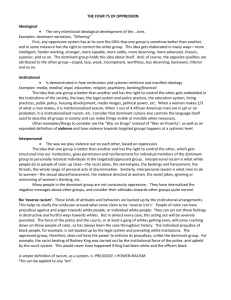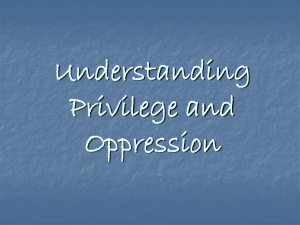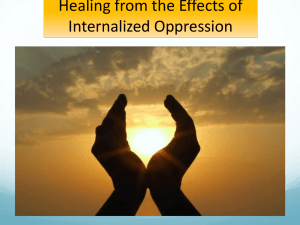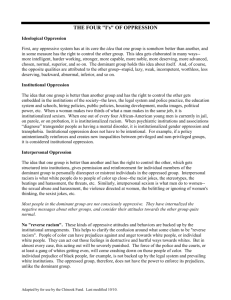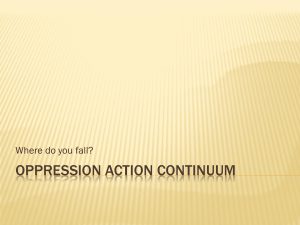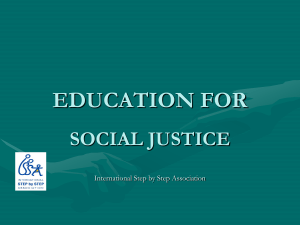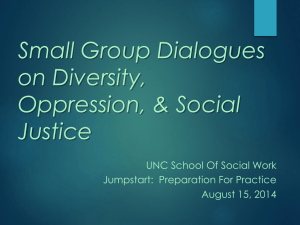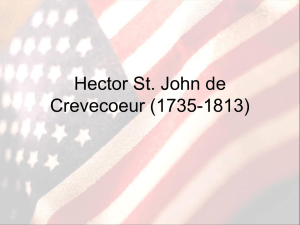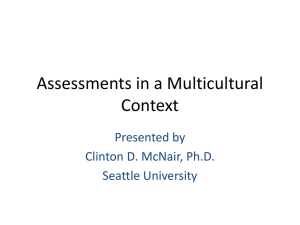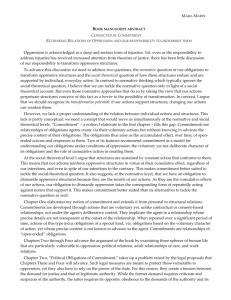social justice
advertisement
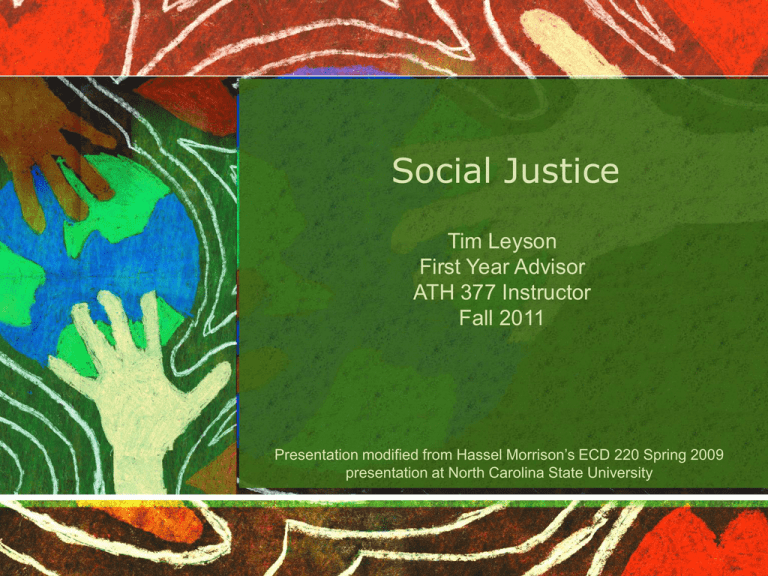
Social Justice Tim Leyson First Year Advisor ATH 377 Instructor Fall 2011 Presentation modified from Hassel Morrison’s ECD 220 Spring 2009 presentation at North Carolina State University Test your knowledge……. • What is Social Justice? • How does Social Justice differ from Diversity? • What does is mean to have cultural competence? • Is more important to have a social justice mind set or focus more on diversity? Let’s start with the basics….. Oppression Oppression = prejudice + power (control/dominance) These dynamics occur between dominant and subordinate groups of people, and are usually determined by common characteristics of groups. The “dominant group” (agent of oppression) is the historically powerful group of people, whose norms have typically prevailed in society. The “subordinate group” (target of oppression) has always been the less powerful group, whose norms and standards are typically criticized or unaccepted in our society Cycle of Oppression 4 Taking responsibility for ourselves and for change in the system 2 1 Born into •Becoming more aware of our roles in the perpetuation of oppression •Taking stands in our lives; personal, interpersonal, and organizational/institutional structures •Unlearning misinformation •Learning correct information •Consciously working toward change •Relative status •Group membership within dominant and subcultures •History Maintains the status quo Internalized oppression Inaccurate/hurtful information we receive from others about ourselves (our groups), which we take responsibility for (internalize). (e.g. we assume it to be true against our better judgement) This affects our attitudes and feelings about ourselves and other groups, as well as our behaviors. •Interpretations of history •Explanations for injustice •Misinformation •Myths and stereotypes •Norms By significant people in our lives Protecting and justifying privileges •Justifying inequities and unjust treatment •Do not make waves; be thankful for what one has •Not questioning structures, norms, messages, ideologies, etc. People “Act Out” Prescribed Roles Taught 3 •Parents •Teachers •Brothers, sisters, and other relatives •Role models •Religious authorities •Political leaders •Reinforced by peers Externalized oppression A subordination, exploitation, and/or mistreatment of a person by an attitude, action, or institutional structure because of her/his membership in a ‘target’ group (women, blacks, Asians, Latino/as, native people, lesbians, gay men, bisexuals, transgender people, children, working class and poor, differently abled, etc.) Examples include: dominant/subordinate behaviors, violence, acting as if more were “normal”, collusion with the oppressive system, intragroup hostility, etc. Reinforced and sanctioned by •Culture, traditions, family •Institutions (media, legal system, government, health care, banks, economy, language, religious institutions, etc.) Internalized vs. Externalized Oppression Internalized Oppression (subordinate group members) Inaccurate/hurtful information we receive from others about ourselves (our groups), which we take responsibility for (internalize), e.g. we assume it to be true against our better judgment. This affects our attitudes and feelings about other groups, as well as our behaviors. Externalized Oppression (dominant group members) A subordination, exploitation, and/or mistreatment of a person by an attitude, action, or institutional structure because of his/her membership in a target group. • Advocating for social justice (the student leader’s role in identifying and responding to oppressive behaviors and attitudes in the residence hall/campus community) • Techniques to responding to oppressive behaviors • What is social justice? – Adams, Bell and Griffin (1997) define social justice as both a process and a goal…………. "The goal of social justice education is full and equal participation of all groups in a society that is mutually shaped to meet their needs. Social justice includes a vision of society that is equitable and all members are physically and psychologically safe and secure." “Social justice includes a version of society in which the distribution of resources is equitable and all members are physically and psychologically safe and secure. We envision a society in which individuals are both self determining (able to develop their full capacities), and interdependent (capable of interacting democratically with others). Social justice involves social actors who have a sense of their own agency as well as a sense of social responsibility toward and with others and the society as a whole.” (Bell, p. 1, Theoretical Foundations for Social Justice education, Teaching for diversity and social justice, 1997) • Key Components of the Definition: – equitable distribution of resources – self-determining and interdependent society – actors who understand themselves, their agencies, and their responsibility to others and society • Being a true advocate means….. – Constant evaluation of self and value system – Breadth of Awareness, ability to see multiple perspectives simultaneously – Depth of Insight, utilizing one’s experience as basis of insight into social justice – Be comfortable demonstrating advocacy • Student Leaders…as Social Justice Advocates – Know and understand frame of reference for members in the community, and act according to the previously stated principles – Demonstrate understanding through programmatic efforts and by role-modeling sincere interest in diverse activities . • Dr. Cullen’s Characters – Blind – Mr. Fix-it – Gag – Invisible – Quiz-Quiz • Blind – This person does “not see color”; sees the world as a utopian place for all. – Common perceptions of this character • Clueless, ingenuine, PC, cheerleader, well-intended; blind to impact of oppression on others • Mr. Fix-It – This person attempts to make everything okay for everyone in the group, and will do and say almost anything to avoid conflict. – Common perceptions of this character • failing to acknowledge and avoids impact of statements; interferes with learning process; hard to know because most of their energy is spent making everything okay, rather than sharing their own ideas • Gag – This person is most likely to remain silent throughout any discussion on diversity issues. – Common perceptions of this character • fearful; presence is imposing but also internalized; attention getter; hiding in silence to remain safe; potentially distracting and can jeopardize trust of group by lack of willingness to open up and share • Invisible – This person tends to be of a social group that is often marginalized, and not typically active in conflict. – Common perceptions of this character •overlooked; self-pitying; aloof; disinterested; can sometimes be confused with gag • Quiz-Quiz – This person emerges as the person in the group who offers a lot of challenge to others in the group, and questions their sincerity. – Common perceptions of this character • holier than thou; judgmental; knows it all; intimidating; doesn’t take part in the learning • Facilitation & Response Techniques – Identifying Self Triggers – Detecting Traps – Making Joining Statements – Allying Behavior • Identifying Self Triggers – A trigger event is any stimulus (external or internal) through which one personally experiences an emotional reaction. Triggers commonly elicit the following responses for facilitators (and other participants): Unexpectedness (surprising arousal of feelings) Strong intense feelings disproportionate to original stimulus Disorientation or speechlessness; “stopped in their tracks” Feeling out of control or overwhelmed Feeling “de-skilled”, therefore reacting less effectively…think later of “what I should have said or did” Feeling the need to make an extra effort to effectively manage the situation • Detecting Traps – Traps are verbal or behavioral stimuli that do any of the following to validate or support oppressive behavior: • Replicate oppressive behavior (validate the behavior) • Inhibit, interrupt, or re-direct “teachable moment” conversations • Rescuing (often used by a third party of a conversation to clarify the intent of the person who’s behavior or statements may intentionally or unintentionally hurt another group member’s feelings) • Limit dialog on discussions relating to oppression • Making Joining Statements – Verbal expression of demonstrating empathy and support others as they share perspectives and insights into oppression. • Examples of Joining Statements: Instead of “that happens to me too…” try “How did it make you feel?” Instead of “I don’t feel/see that…” try “Why do you feel that way? • Allying Behavior – Taking in anger or demonstration of frustration, setting aside how it impacts you, and asking/ acknowledging the person’s feelings, asking them what has happened. An example of allying behavior is the use of joining statements. Becoming an Ally Someone from the agent/dominant group who will stand in the way of oppression when it is aimed at a target/subordinate group. Someone who will recognize her/his privilege as a member of the dominant group and will question oppression. Four basic levels of becoming an Ally: 1. Awareness (who am I and how am I different) 2. Knowledge/Education (learn about a groups history, culture, norms, experiences, contributions; how do laws, policies, stereotypes impact individuals and the group as a whole) 3. Skills (develop skills in communicating what you have learned) 4. Action (speaking/acting out against injustice; can be most frightening; if you choose not to act, pay attention to the impact your inactivity has on you and the target group) • Group Discussion – How do you motivate yourself and others to reach beyond your/their comfort zone to learn about diversity?
